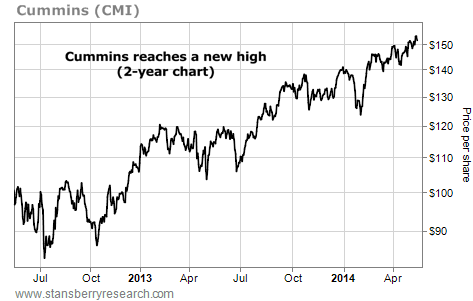| Home | About Us | Resources | Archive | Free Reports | Market Window |
This Word Comes Right Before Big Investment GainsBy
Friday, May 16, 2014
Thousands of investors just learned a painful lesson...
They learned the word "exciting" comes right before big investment losses.
But there's one word that often comes right before investment gains, which I'll tell you about in a moment. But first, let's talk about Twitter...
Since the start of the year, Twitter shares are down 50%.
Last week, Twitter shares fell 17% in a single day.
I've never owned Twitter stock... and never will.
Twitter and a whole slew of technology stocks have high valuations even though they sell nothing but ways to waste time for people with nothing better to do.
Why would I care when a Hollywood celebrity goes out to eat dinner? Do I need a sports star to remind me to "pray" for the victims of some televised disaster?
Despite my thoughts on the matter, investors have lined up to buy stocks like Twitter. And now they are paying for it.
But at the same time these soaring tech stocks were collapsing, a different group of tech stocks were holding their value or even rising.
Companies such as Cisco (CSCO) and Intel (INTC) performed well. So did software giant Microsoft (MSFT), mobile-phone-technology developer Qualcomm (QCOM), software firm Oracle (ORCL), and others.
These tech companies aren't exciting to most investors... In fact, many would even call them "boring."
As regular readers know, I like to call these types of stocks "Digital Utilities." And although they may seem like "boring" businesses, the mountains of cash they produce and return to shareholders are anything but...
Rather than touting some hot new device or social-media service that wastes everyone's time, these companies provide technology services that are ubiquitous and a part of our daily lives.
For example, whenever you use your PC, you're certain to be using Microsoft's operating system. Whenever you connect to the Internet, the traffic is passing through Cisco servers. Whenever your smartphone makes a call, it's using a Qualcomm chip.
And separating these real businesses from the risky ones is simple. All you have to do is look for a few simple signs that show which tech stocks will deliver safe profits.
One of the most obvious ways to separate the risky stocks from high-quality Digital Utilities is their price multiples. Stick with companies that trade at low metrics, like price to earnings, book value, or sales.
To show you what I mean, we'll look at price-to-earnings (P/E) ratios. But you can use almost any traditional measure such as price-to-sales or price-to-book ratios and see roughly the same thing. Look at how wildly overvalued Amazon (AMZN) and Facebook (FB) are compared with other big tech firms...
 So while blue-chip tech firms Apple (AAPL), Cisco, Intel, and Microsoft all trade for 13-14 times earnings... Amazon trades for an indefensible 470 times earnings. Twitter has no earnings, so its ratio is infinite. Its P/E is literally incalculable.
Now, some people may be tempted by these high-flying tech stocks. After all, some of them could be the "next big thing" and grow many times over – making a fortune for you if you get it right.
That may be true... but as we've seen over the past few months, you can earn even better returns by sticking to the old, "boring" cash producers.
Although these companies may not be very exciting to most investors, the consistent returns they generate will protect you from the wild swings we've seen recently in stocks like Twitter... and help you sleep better at night.
To our health, wealth, and a great retirement,
David Eifrig Jr.
Further Reading:
If you don't have a portfolio full of great stocks yet, Doc recently shared his advice for where to get started. "You can start with as little as $25 a month to work your way to financial independence," he writes. Learn more in Doc's two-part series here and here.
"For many years now," Doc writes, "I've made a bold claim... that retirees could safely earn 12%-20% income streams on their savings. I know it sounds crazy... but my readers have used the strategy behind this claim to close 108 consecutive winning positions." Get all the details here: How to Collect the World's Safest Double-Digit Yields.
Market NotesCHECKING OUR HIGH-HORSEPOWER ECONOMIC INDICATOR Another week, another new high for Cummins (CMI). Regular readers know that's a good thing for the global economy.
Over the past three years, we've run dozens of charts that show the global economy may not be "booming," but it's doing much better than the pessimists would have you believe. For example, we've pointed to the rising profits and share prices of shippers, hotels, and home-improvement firms.
Another thing rising is the share price of Cummins. Cummins is the world's largest independent maker of high-horsepower diesel engines... the kind that power bulldozers, cranes, heavy trucks, mining shovels, and electrical generators. This makes its share price rise and fall with the pace of economic activity. For example, we noted the stock's big breakdown in January 2008, which came well before the economic crisis.
Today's chart shows there's no crisis at Cummins right now. From mid-2012 to mid-2013, the stock climbed from $90 per share to $115. Since then, it has continually registered new highs as business has improved. This tells us businesses are doing lots of driving, digging, lifting, and shoveling... which means things "can't be all that bad" right now.
 |
Recent Articles
|



